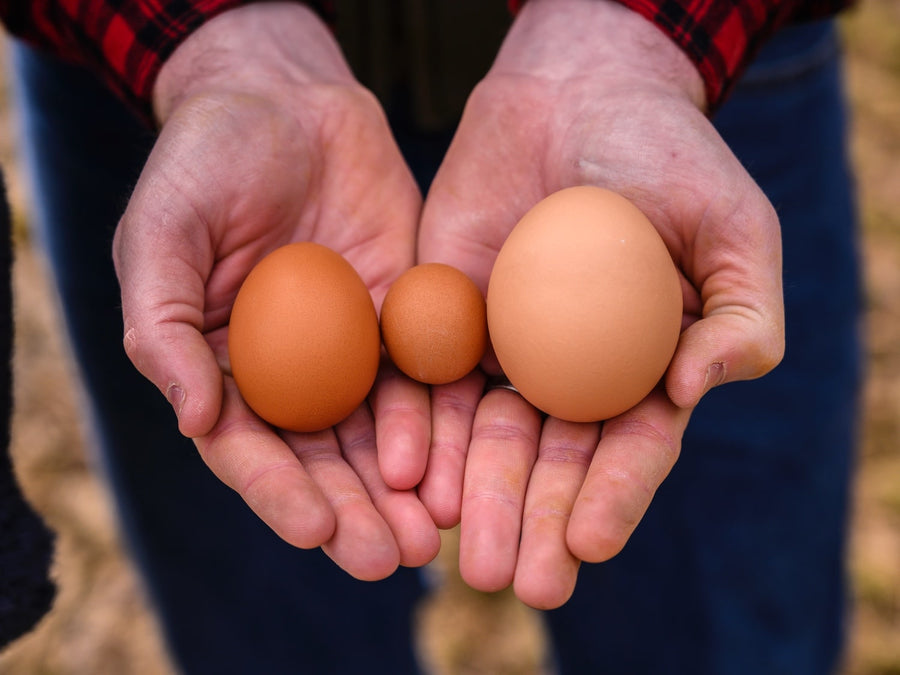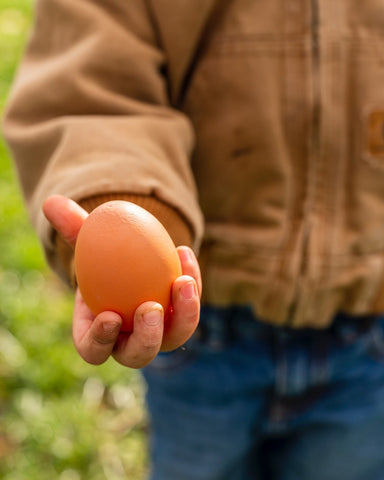Understanding Egg Sizes: From Peewee to Jumbo
Have you ever opened up a carton of eggs and noticed that one or two of them didn't look quite up to size? Contrary to popular belief, egg size is determined by weight, not by volume. For this reason, it's not uncommon to see some visual variation in the physical size of eggs from time to time, even within the same carton. And while medium and large eggs are the most common options in the grocery store, hens lay a wide range of egg sizes, from peewee to jumbo. Read on to learn all about different egg sizes, how they're determined, and which factors influence the size of a hen's egg.
How egg sizes are determined
In the United States, the US Department of Agriculture (USDA) is responsible for setting standards for egg sizes, and does so by determining minimum weights per dozen. That's right: according to the
USDA, "size tells you the minimum required net weight per dozen eggs. It does not refer to the dimensions of an egg or how big it looks. While some eggs in the carton may look slightly larger or smaller than the rest, it is the total weight of the dozen eggs that puts them in one of the following classes." This may seem counterintuitive, but it explains why there tends to be some visual variation in most egg cartons. Sizing by dozen rather than by individual egg weight also helps eliminate waste in the egg industry, ensuring that all eggs find their way into a carton.
Guide to egg sizes and weights
The USDA outlines six weight classes for consumer grade shelled eggs: peewee, small, medium, large, extra-large, and jumbo.
Peewee
Peewee eggs, the smallest weight class, are said to be the rarest size. They're often known as pullet eggs, which means they're laid by very young hens. Peewee eggs weigh in at minimum of 15 ounces per dozen.
Small
Like peewee eggs, small eggs come from hens that are just starting their laying cycle. They often resemble quail eggs in size. Small eggs weigh in at minimum of 18 ounces per dozen.
Medium
Since shell thickness correlates to egg size, medium eggs are a fantastic option for
hard-boiling because they have slightly thicker shells than large eggs, making them easier to
peel. Medium eggs weigh in at minimum of 21 ounces per dozen.
Large
Large eggs are the most common size for hens in the prime of their laying days, and therefore the most widely available. Most recipes (especially when it comes to
baking) are written with large eggs in mind, whether size is specified in the recipe or not. Large eggs weigh in at a minimum of 24 ounces per dozen.
Extra-Large
When you want a little extra oomph in your scramble, go with extra-large eggs. Almost as common as large eggs, they're a great choice for all your non-baking needs (but can be substituted for large eggs in a pinch). Extra-large eggs weigh in at a minimum of 27 ounces per dozen.
Jumbo
Jumbo eggs are the largest weight class and tend to come from bigger-bodied hen breeds, or from hens that are still acclimating to their laying cycle. Jumbo eggs weigh in at a minimum of 30 ounces per dozen.
Bonus: double yolks and fairy eggs
When you pick up a carton of our jumbo eggs, you might be lucky enough to find a
double yolk (or a whole dozen!) inside. These eggs are technically considered "super jumbos." In the grand scheme of things, double yolks are very rare—but because our super jumbos are so large that they have to be packed by hand, they tend to end up in the same carton. Meaning if you discover one double yolk, chances are the eggs nearby will be filled with extra golden goodness too. On the other end of the spectrum, there are eggs so small that they don't even contain a yolk. These are known as fairy eggs, and while they're fascinating to see in person, it's very unlikely that you'll find one in our cartons.
Discrepancies in egg sizing
Sometimes certain egg sizes are in higher supply than others. The
USDA states that "it is permissible to pack the next larger size of eggs into cartons (for example, large eggs packed in medium cartons), provided they are not intermingled in the same carton with the lower marked weight class.” This means that to fulfill an order, for example, large eggs can be packaged in cartons labeled "medium"—which is why you may come across a carton of eggs that seem bigger than you're used to from time to time.
What determines the size of an egg?
The physical size of an egg depends on a number of factors, some of which are related to the hen herself, and others having to do with her environment and surroundings. Some of the most impactful factors include age, breed, season, and lighting.
Age
A hen's age is perhaps the most important factor that determines the size of her egg. However, the correlation between age and egg size isn't exactly a straight line: pullets and young hens have been known to lay eggs on both extremes of the size spectrum, from peewees to jumbos. Hens in their prime laying days tend to lay more consistently, usually producing medium and large eggs on most days.
Breed
A hen's
breed determines the size of her frame, which helps determine the size of her eggs. Breeds like Jersey Giants, Cochins, and Orpingtons, for example, are larger birds and therefore lay larger eggs. On the other hand, Bantam hens are smaller than an average chicken and tend to lay eggs to match.
Season and lighting
Just like humans, hens have internal clocks, so the time of year plays a big role not only in their laying frequency, but sometimes in the size of their eggs. In the
winter, hens naturally stop laying unless provided with artificial lighting—and even those that continue to lay will often lay smaller eggs.
How does Pete & Gerry's determine egg sizes?
Sizing up our eggs is no simple task at Pete & Gerry's. In fact, we have it down to a science to ensure that every carton of eggs from our small family farms meets consumers' expectations, every time. Here's how we do it:
At the beginning of each day, our mechanics calibrate our scales to ensure that they are maintaining the integrity of our egg weight specifications. This is recommended by the manufacturers of our equipment and is documented within our facility. Our mechanics keep strict records on the proper calibration of our machines and record calibration checks on a daily basis.
From there, our machine operators assign packers to certain eggs based on egg weight. The product that matches those specifications is then run through the respective pack line. For example, if a packing line is assigned to large sized eggs, the computerized system will only send large-weight eggs to be packaged into our large-labeled cartons. The computerized system prohibits eggs weighing less than the USDA standard for large to become packaged in a large line. Our computers also track the total weight of all large eggs processed during the day so that we can verify that the average weight of a specific type of egg was within the determined weight parameters.
Beyond our calibrated scales, we have personnel on the packing line who routinely document manual weights of our finished product to check that we are sending out finished product that meets these strict weight requirements. We also have USDA personnel on site who ensure we are following these expectations and strict guidelines very closely. This is just one leg in the journey of an egg, but it's an important one.








